Key Takeaways:
- Flexibility in Feline Training: Toilet trained cats can adapt to using a litter box with proper guidance and patience.
- Health and Comfort Considerations: Transitioning back to a litter box might be necessary for a cat's health and comfort.
- Behavioral Insights: Understanding your cat's preferences and behaviors is crucial in managing their bathroom habits effectively.
Cats are creatures of mystery and elegance, often surprising their human companions with their capabilities and quirks. Among these quirks is their ability to be trained for different types of bathroom habits, including using a human toilet or a litter box. But what happens when you need to switch from one to the other? Can a toilet trained cat revert to using a litter box? Let's dive into this intriguing topic with a blend of humor and practical insights.
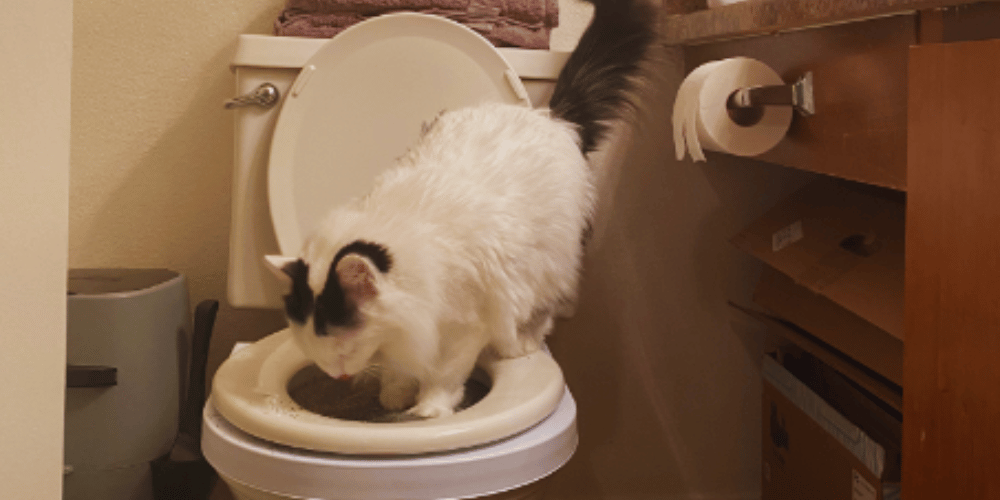
The Great Debate: Toilet Seat vs. Litter Box
When you've successfully managed the feat of toilet training your cat, you might feel like you've hit the jackpot. No more dealing with kitty litter, the smell, or the mess! However, life is full of surprises, and sometimes, circumstances require a change. Whether it's a move, a health issue, or simply a change in living arrangements, you might find yourself pondering if your toilet-trained feline can transition back to a litter box.
Understanding the Basics of Feline Bathroom Habits
Cats are naturally inclined to cover their waste, a trait inherited from their wild ancestors. This instinct makes them amenable to using litter boxes, where they can dig and cover to their heart's content. Toilet training, on the other hand, requires them to defy this natural instinct, which they can do, but not without effort from both the cat and their human.
The Transition: Is It Possible?
Yes, it is entirely possible for a toilet-trained cat to start using a litter box again. However, this transition should be handled with care and patience. The key is to make the litter box as appealing as possible and to place it in a quiet, accessible location. Initially, you might even place the litter box near the toilet to help your cat make the mental connection.
Choosing the Right Litter Box: A Crucial Step
The type of litter box you choose can significantly impact how well your toilet-trained cat adapts to it. Covered litter boxes might offer the privacy some cats prefer, which is similar to the isolation of a toilet. On the other hand, an open box might be less intimidating for a start.
Size and Location Matter
Ensure the litter box is spacious enough for your cat to move around comfortably. The location should be quiet, away from high traffic areas, yet easily accessible. Avoid placing it near their food or water, as cats usually don't like to eliminate close to where they eat.
Litter Type: Clumping vs. Non-Clumping
The choice between clumping and non-clumping litter can also affect your cat's willingness to use the box. Many cats have a preference, often developed early in life. If your cat was used to non-clumping litter before toilet training, reintroducing the same type might help ease the transition.
Health Considerations: When to Switch Back
Sometimes, the decision to switch from a toilet to a litter box is driven by health concerns. Older cats, for instance, might find the physical act of jumping onto the toilet challenging as they age. Cats with medical issues such as a urinary tract infection might also benefit from a litter box, where monitoring their output is easier.
Monitoring Health Through the Litter Box
Using a litter box allows you to keep an eye on your cat's waste for signs of health issues. Changes in frequency, consistency, or color can be early indicators of problems that require veterinary care. This monitoring is something you give up when your cat uses the toilet.
Comfort and Accessibility
As cats age, their mobility can decrease, making the jump to a toilet difficult or painful. A litter box on the ground is much more accessible and can prevent accidents or discomfort.
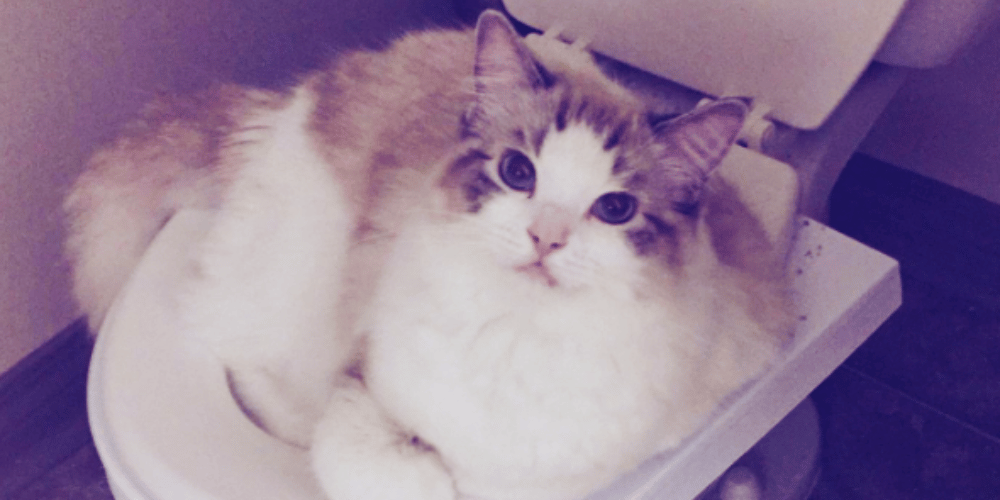
The Comedic Trials of Litter Box Training
When you decide to train your cat to use a litter box, you might imagine it's as simple as pointing to the sandy rectangle and giving a thumbs up. However, cats aren't big on human gestures, especially when it comes to their bathroom habits. Imagine the scene: you place your furry friend next to the box, and with a hopeful smile, you watch as they step in, sniff suspiciously, and then casually walk away to eye the bathroom floor. It's not just a box; it's a cat's personal spa, and the introduction must be made with finesse!
Now, let's talk about the location. If you thought moving your furniture around was a hassle, try relocating a litter box. Cats have a GPS for their preferred toilet spots that rivals any high-tech system. Move their litter box, and you might find your kitty has left a not-so-pleasant surprise in the old spot. It's like they're saying, "Oh, you thought the box was better by the window? I thought the middle of the living room carpet was quite nice." Ensuring the box is in a quiet, accessible spot can make litter box training less of a comedic drama and more of a success story.
The Enigmatic Science of Cat Litter Preferences
When it comes to the art of successful litter training, one must consider the whimsical world of cat preferences. Cats, much like their human counterparts, have their own likes and dislikes, which can make the transition from toilet train to cat box an amusing spectacle. For instance, some cats might treat a newly introduced non-clumping litter with suspicion, akin to a toddler encountering broccoli for the first time. They might poke it, sniff it, or completely ignore it, opting instead to watch you clean up after their deliberate miss. This initial reaction is crucial as it sets the tone for either a smooth transition or a battle of wills.
On the other hand, moving the litter box can sometimes feel like redecorating a room for a particularly picky teenager. If the litter tray is moved just a few inches, it might as well have been shifted to a new dimension as far as your cat is concerned. The location, the type of litter, and even the style of the box (open vs. covered box) play significant roles in whether your feline feels comfortable enough to use it. It's not just about placing a box; it's about integrating it into their comfort zone in such a way that they feel it was their idea all along.
The Purr-fect Spot: Why Location is Everything for Your Cat's Litter Box
When it comes to helping your cat use the litter box consistently, think real estate: location, location, location! Placing the litter box in a quiet, low-traffic area where your cat feels safe is crucial. Imagine trying to do your business while someone watches—awkward, right? Cats feel the same way. If the litter box is moved frequently or placed next to noisy appliances like a washing machine, don't be surprised if your cat protests by choosing a more peaceful spot—like your sock drawer!
Moreover, ensure the area around the litter box is free of strong smells. Cats have sensitive noses, and overpowering scents can deter them from entering their bathroom area. Avoid placing the litter box near their food or water bowls because, just like humans, cats aren't fans of eating in their bathrooms. A consistent, well-chosen location helps prevent accidents and keeps your home smelling fresh. Remember, if your cat likes the spot, you'll save yourself a lot of trouble!
The Litter Box Shuffle: When and How to Move It
Moving your cat's litter box can sometimes feel like you're negotiating a peace treaty with a furry little dictator. But fear not! Strategic relocation is sometimes necessary, especially if you're noticing your cat is avoiding its current spot. Perhaps it's too noisy, too high traffic, or your cat just fancies a change of scenery. The key is to move the litter box gradually to the new location, shifting it a few feet every day so your cat doesn't boycott the new site out of spite.
However, be warned, moving the litter box isn't always a walk in the park. If your cat starts showing signs of distress or begins leaving unwanted 'gifts' outside the box, it might be time to reconsider your strategy. Sometimes, what seemed like a minor change to you can be a big deal to your cat. Keep an eye on your cat's behavior during this transition and be ready to switch tactics if you're making the problem worse. Patience and observation are your best tools when it comes to these feline negotiations.
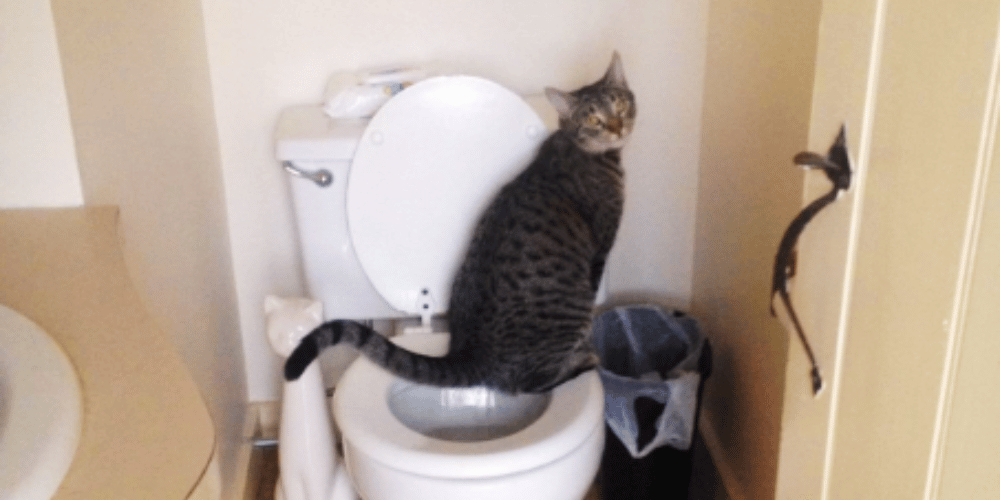
The Weighty Issue: Monitoring Your Cat's Health via the Litter Box
When it comes to monitoring your cat's health, their litter box can be a treasure trove of information. A sudden change in weight can be a subtle hint that not all is well with your furry friend. For instance, if you notice that the amount of litter used is decreasing, it might be time to check if your cat's weight has dropped. This could be a sign of health issues that require a vet's attention. Regular monitoring can help catch these changes early, ensuring your cat remains in purr-fect health.
Moreover, for pregnant women, being vigilant about the litter box is crucial due to the risk of Toxoplasma gondii, a parasite found in cat feces that can cause toxoplasmosis. Using a non-clumping litter can make it easier to clean and maintain the box regularly, reducing the risk of exposure. It's advisable to wear gloves and wash hands thoroughly after handling the litter box, or better yet, delegate this duty to someone else during pregnancy.
The Social Dynamics of Litter Boxes: Training Multiple Cats
Training multiple cats to use a single litter box can be like directing traffic at a busy intersection! It's essential to understand that cats are territorial creatures, and sharing a box might not always go down well. To prevent any hissy fits, it's wise to have multiple litter boxes around the home—one per cat, plus one extra. This ensures everyone has their spot, and helps reduce conflicts.
If you've recently moved and need to get the litter box moved to a new spot, do it gradually. Cats might feel disoriented and stressed if their bathroom suddenly disappears to a new location. Start by moving the litter box closer to the new location over a few days. This slow shift can help ease their stress and make the transition smoother, ensuring that the litter box remains a place of comfort and not a source of territorial disputes.
The Diet-Litter Connection: What Goes In Must Come Out
Ever wonder if what you're feeding your cat affects what ends up in the litter box? Well, you're onto something! Cats on a diet primarily consisting of dry food might have different litter box habits compared to those feasting on canned food. The moisture content in canned food helps keep your cat's digestive system a bit more regular and can lead to more predictable bathroom habits. This can be particularly helpful for monitoring your cat's health through their poop, an activity beloved by vet professionals and possibly over-zealous pet parents.
On the flip side, if you're noticing that your cat's litter box outputs are becoming problematic—too hard, too soft, or just plain odd—it might be time to examine their diet. Adjustments in what you feed them can be a simple solution to litter box woes. Remember, a healthy cat diet leads to a healthy cat, and a healthy cat means a less stinky litter box. So, keep an eye on what goes into your cat, because it will definitely affect what comes out!
Litter Logic: Choosing Between Clumping and Non-Clumping Litter
Deciding between clumping and non-clumping litter isn't just a matter of personal preference—it can significantly impact how effectively you can litter train your cat. Clumping litter is like the detective of the litter box world; it helps you monitor your cat's health by forming neat, scoopable lumps whenever your cat goes to the bathroom. This makes it easier to keep the box clean and spot any unusual changes in your cat's waste, which could indicate health issues.
On the flip side, non-clumping litter absorbs moisture and odors but doesn't form clumps, which can make cleaning a bit of a treasure hunt. It's generally less expensive and might be a better choice for kittens or cats recovering from surgery, as it's softer on their paws. Whichever type you choose, make sure it's unscented to keep your cat happy and willing to use the litter box. Remember, the right tools, including the type of litter you choose, can make the problem of litter training significantly easier to manage.
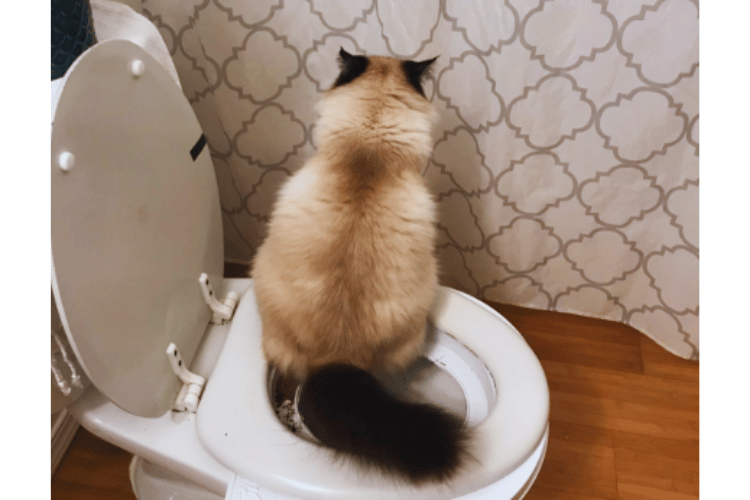
The Comical Conundrum of Multi-Cat Litter Training
Introducing a new kitten to the dynamics of an existing cat's litter box can be as tricky as negotiating peace talks among toddlers. Each cat is a unique individual with distinct preferences. For instance, older cats might not appreciate sharing their space with a frisky newcomer. This can lead to a hilarious yet frustrating game of hide-and-seek with the litter box, where the older cat decides to boycott the box entirely, leaving 'surprises' in protest. The key to successful litter training in multi-cat households lies in understanding each pet's personality and needs, ensuring everyone has their own space.
Moreover, the drama unfolds further when you consider the different reactions to the type of litter used. Some cats might prefer the fine, sandy texture of less litter, while others might favor a more pellet-like consistency. Observing your cats' preferences and adjusting accordingly can turn a potential turf war into a peaceful coexistence. Remember, while dogs might face challenges with a wag and a bark, kitties solve their problems with a purr and a paw, making each step in the litter training process a lesson in patience and humor.
Enzymatic Cleaners: The Unsung Heroes in Cat Toilet Training
When embarking on the journey of toilet training cats, one must not underestimate the power of a good enzymatic cleaner. Picture this: your cat has finally started using the litter box, but oops, there’s a miss right next to it. Instead of the usual scrub and frown routine, using an enzyme-based cleaner can turn your frown upside down. These cleaners break down the mess at a molecular level, essentially telling your cat, "Nothing to see here, move along," which helps prevent repeat offenses.
But it's not just about cleaning up; it's about setting the stage for a blockbuster training session. Using these cleaners ensures that your bathroom floor doesn’t become the new hot spot for all the wrong reasons. Think of it as the backstage crew in a play, unseen but essential. By removing lingering odors, you help your cat forget the bathroom floor was ever an option, steering them back to the litter box with their script in paw, ready to perform like the star they are.
Behavioral Issues and Litter Boxes
Behavioral issues can sometimes prompt a switch back to the litter box. Inappropriate elimination, such as going outside the toilet, can be a sign of stress or dislike for the current arrangement.
Stress and Anxiety
Changes in the household, such as new pets or even new house members, can stress your cat. This stress might manifest in bathroom habits, where a litter box could offer more security and comfort.
Territorial Marking
In multi-cat households, a cat might feel the need to mark its territory, something that's difficult to do with a toilet. A litter box can provide a sense of ownership and control, reducing stress and conflict among cats.
Practical Tips for Transitioning
If you decide that moving back to a litter box is the right step, there are practical ways to make this transition smoother for both you and your cat.
Gradual Introduction
Start by placing the litter box near the toilet, gradually moving it to where you want it permanently. This slow transition can help your cat adjust to the new situation without too much stress.
Positive Reinforcement
Use treats and affection to encourage your cat to explore and use the new litter box. Positive reinforcement can make the transition a positive experience for your feline friend.
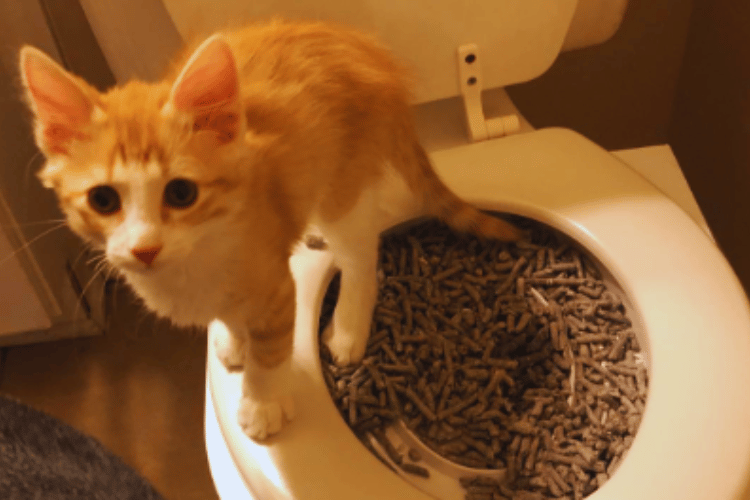
Summary
Transitioning a toilet-trained cat back to using a litter box is entirely feasible with the right approach and understanding of your cat's needs. Whether driven by health, age, or behavioral changes, this switch can be managed effectively by choosing the right litter box, understanding your cat's preferences, and using positive reinforcement.
FAQ
Can all cats be trained to use the toilet and then switch back to a litter box?
Most cats can be trained for both, but individual preferences and capabilities can vary. It's important to consider your cat's health and comfort.
What are the signs that my cat prefers a litter box over the toilet?
Signs include avoiding the toilet, accidents in the house, or visible stress when attempting to use the toilet. Observing your cat's behavior closely will give you clues.
How long does it take for a toilet-trained cat to adapt to a litter box?
The adaptation period can vary, but with consistent training and positive reinforcement, most cats can make the transition within a few weeks.
Thank you for visiting LegitLists we hope this helps you make a legitimate choice!






